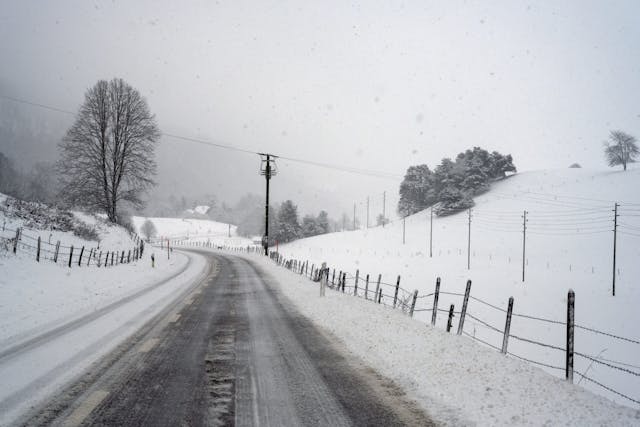Snow joke: Hyundai reinvents automatic tire chains
A tire with built-in deployable snow chain technology could put an end to any winter driving worries.
Hyundai and Kia appear to have taken a leaf out of the Q-Branch book with the kind of device you’d expect to see on 007’s Aston Martin. The Snow chain-integrated tire technology makes use of shape memory alloy modules positioned inside the wheel and tire. At the press of a button these extend out beyond the tire to bite into snow and ice and keep you moving.
The wheel and tire have radial grooves that slice the circumference not unlike a pizza. Inserted into these slots is a shape memory alloy that changes form when an electrical current is applied. In fair weather the alloy is compressed into an ‘L’ shape and sits below the tire surface, but when the driver needs extra traction a simple push of a switch alters the alloy into a ‘J’ form, pushing it out beyond the tire.
That means no more frozen fingers as you struggle to install a set of chains. In fact, there’s no need to stop at all.
The patent-pending technology “will hopefully be introduced on Hyundai and Kia vehicles someday,” says Joon Mo Park, Head of Advanced Chassis Development Team, so if you live in a snow zone then you’ll need to keep your standard chains handy for a few years at least.
***
Check out the Hagerty Media homepage so you don’t miss a single story, or better yet, bookmark it. To get our best stories delivered right to your inbox, subscribe to our newsletters.



As a guy who first installed them back in the ’50s when my disabled father sent me out to chain up his ’55 Chevy P/U, has put them on countless times on countless vehicles since (up to and including school busses and semi-trucks with double trailers), I can only look at this and say, “Hoo-Boy, someone has WAY too much time on their hands”! Q-Branch worthy, indeed, but I predict these will not go any further than the colored glow-in-the-dark tires I snickered at in a prior column.
Coming from a snowy region of the country, I’ll say my opinion is that if you dearly desire “no more frozen fingers as you struggle to install a set of chains”, you probably don’t belong on the roads if they are the least bit slick.
Nik, we had “studded” tyres in the 1970’s which were outlawed. Gee it seems today’s auto genuses don’t have any knowledge of history before the I-phone…. Ok what is your next great breakthrough, tubeless tyres????
Considering they seem to be going backwards, my guess is eco-friendly wooden spoke rims
But these ‘studs’ retract when not in use. There was a scheme to achieve this with plastic inserts surrounding the tungsten, reacting to ‘hysteresis’ pressure to clench and retract. I haven’t heard of it in several decades, and still wonder.
And what happens when the tread wears down? Winter ready for slush when it freezes on the electric mechanism? Test results?
They need to focus more on their engines blowing up right now vs this.
#1 chains are really not in great needs anymore on most vehicles with the tires and electronics we have today. Most cars can not even use a chain due to no clearance.
#2 Any car that requires a special wheel is nearly doomed from the start. Recall the TRX Mustang wheels. Owners could not wait to get rid of them and it was an added cost all the way around.
#3 Most drivers today struggle in snow for two reasons. One they can’t drive in the snow and lack control skills. Second many have bald tires as people get the last bit from tires as they can be very expensive for some folks.
Everyone keeps trying to reinvent the wheel but it is not an easy or cheap thing to upset the entire system that is used on most cars today. Even the Airless tires are not exactly rushing to market. You may see them on a lawn mower but cars will take time.
The early run flats required a special wheel till Goodyear did a run flat for the Corvette on stock wheels. Even then they are stiff, expensive and heavy.
What’s the durability of the chain elements when the tires are spinning during transitions between slippery and wet or dry pavement? What about lateral traction? This design may work fine when driving in a straight line, but it likely adds little or no additional grip when cornering.
So proprietary tires for these cars, what will that mean for the replacement? Will only the Hyundai/Kia be able to deal with it, how much more will this cost? Snow tires on a separate set of wheels sounds like a smarter plan.